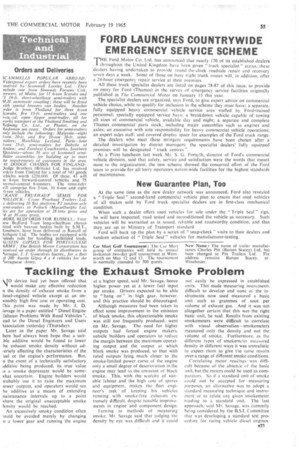Tackling the Exhaust Smoke Problem
Page 57

If you've noticed an error in this article please click here to report it so we can fix it.
VO device had yet been offered that "I would make any effective reduction n the density of exhaust smoke from a liesel-engined vehicle except at an immssibly high first cost or operating cost. ['his .point was made by Mr. J. D. lavage in a paper entitled "Diesel Engine -32chaust Problems With Road Vehicles ", ead to the Diesel Engineers and Users 4ssociation yesterday (Thursday).
Later in the paper Mr. Savage said here had always been hope that a suit.ble additive would be found to lower he ,exhaust Smoke .density without adtersely affecting the characteristics of the 'uel or the engine's performance. But,
n the event of a technically satisfactory idditive being produced, its true value is a smoke depressant would be somewhat uncertain. Engine builders would irobably use it to raise the maximum lower outputs, and operators would see he additive as a means of extending naintenance intervals up to a point where the original unacceptable smoke lensity would be reached.
An excessively smoky condition often :ould be avoided merely by changing o a lower gear and running the engine at a higher speed, said Mr. Savage, hence higher power yet at a lower fuel input per stroke. Drivers expected to be able to "hang on" in high gear, however. and this practice should be discouraged.
Although measures had been taken to effect some improvement in the emission of black smoke, this objectionable smoke was still too frequently produced. went on Mr. Savage. The need for higher outputs had forced engine makers. vehicle builders and operators to reduce the margin between the maximum operating output • and the output at which black smoke was produced, so that with rated outputs lying much closer to the smoke-limited power curve of the engine only a small degree of deterioration in the engine may lead to the emission of black smoke. This, with the scarcity of suitable labour and the high cost of spares and equipment, makes the fleet engineer's task of keeping his vehicles running with smoke-free exhausts extremely difficult, despite notable improvements in engine and component design.
Turning to methods of measuring smoke. Mr.. Savage said that judging the density by eye was difficult and it could not easily be expressed in established units. This made measuring instruments difficult to develop and none of the instruments now used measured a basic unit such as grammes of soot per volume of exhaust gas. And it was not altogether certain that this was the right basic unit, he said. Results from existing smokemeters were difficult to correlate with visual observation—smokemeters measured only the density and not the volume of smoke. Furthermore, as the different types of smokerneter measured density in different ways it was unrealistic to expect them to give the same results over a range of different smoke conditions.
Correlating meter readings was difficult because of the abseme of the basic unit, but the meters could be used as comparators. So if a standard unit of smoke could not be accepted for measuring purposes, an alternative was to adopt a standard measuring technique and instrument or to relate any given smokemeter reading to a standard unit. The last approach, said Mr. Savage, was currently being considered by the B.S.I. Committee that was developing a standard test procedure for rating vehicle diesel engines.




































































































































